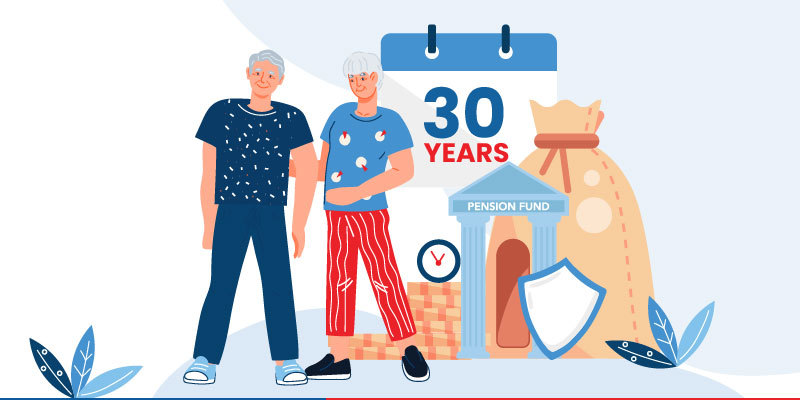What do you want to do?
Safeguard Your Financial Future with a 30-Year Retirement Plan

Table of Content
1. What is a 30-Year Retirement Plan?
2. Key Features of a 30-Year Pension Plan
3. Why Choose a 30-Year Retirement Plan?
4. Who Should Consider a 30-Year Pension Plan?
5. How Does a 30-Year Pension Plan Work?
6. Tax Benefits on 30-Year Retirement Plans
7. Frequently Asked Questions (FAQs) on 30-Year Retirement Plan
What is a 30-Year Retirement Plan?
A 30-year retirement plan, as mentioned above, is a long-term approach. Here, you consistently invest over a span of three decades to build a secure income for your golden years. Think of it as a financial roadmap, i.e., the one that grows steadily with time and endows high-level stability when you retire.
Unlike short-term retirement plans, which concentrate on quick returns/limited savings, a 30-year plan permits your money to compound well, endowing you with higher potential returns as well as better protection against inflation.
This makes a 30-year plan not just a secure choice but also well-aligned with current financial planning trends. Note that the plan is well-suited for young earners who want to begin early and mid-career professionals aiming to strengthen their retirement corpus and long-term planners looking out for assured income and mental peace post-retirement.
Key Features of a 30-Year Pension Plan
Guaranteed pension income, flexible premiums, lump sum plus annuity options, tax benefits1 under Sections 80CCC and tailored payout modes for better money management.
Guaranteed Pension Income
A 30-year pension plan assists you in steadily creating a post-retirement corpus through investments over a long-term period. For decades, your contributions have grown due to the effect of compounding. This ensures a robust financial footing.
Once you retire, this corpus gets converted into an assured income stream, endowing high stability and mental peace during your non-working years
Extended Premium Payment Flexibility (for a span of up to 30 years)
Such plans offer high flexibility on premium payments over an extended period of up to 30 years. This makes them well-suited for differing life phases.
Whether you are a young financial professional just starting out or a mid-career earner with differing income priorities, you can choose a premium schedule that matches well with your budget and goals.
Option for Lump Sum plus Annuity
With this benefit, policyholders can make the most out of a balanced payout, i.e., a part of the maturity benefit can be taken as a lump sum for immediate requirements like clearing off loan EMIs or travel purposes.
However, the remainder can be converted into an annuity for periodic income. This dual benefit ensures thorough liquidity and long-term financial support.
Tax Benefits under Section 80C, 80CCC and 10(10D)1
Retirement plan contribution for a 30-year period qualifies for deductions under Section 80CCC1 of the Income Tax Act, 1961 upto ₹1.5 lakh per financial year Additionally, Upon maturity/vesting, commutation benefit received shall be exempt as per Section 10(10A), subject to prescribed conditions as per the Income Tax Act, 19611. However, Note that the annuity income received post-retirement is taxable as per your income tax slab.
Flexibility in Payout Modes (i.e., Monthly/Quarterly/Annually)
Every retiree has varying lifestyle requirements. That is why a pension plan of 30 years enables you to tailor your payout frequency, be it on a month-on-month basis for periodic expenditures, quarterly for periodic bills or annually for planned spending.
This flexibility assists you in better managing cash flow in a smooth manner and even maintaining your prevailing lifestyle post-retirement.
Why Choose a 30-Year Retirement Plan?
It assists you in building substantial wealth over the long-term period. This ensures financial security over the long term and tax advantages1 and endows flexible payout options, especially for your retirement goals.
Wealth Creation Over the Long Term for Young Earners
A 30-year retirement plan endows young earners just the right head start to secure their future. Even if you begin a little late, the long tenure allows your money to grow through compounding, helping you build a sizable corpus without waiting for decades.
The earlier you begin, the more your wealth gets multiplied in an effortless manner.
Financial Security Throughout Retirement
With assured pension payouts, this plan ensures a steady flow of income post-retirement, so you are not only dependent on your savings or unpredictable market returns.
It endows confidence that your essential expenditures and lifestyle requirements will be comfortably met throughout your golden years.
Tax Benefits Over Decades
Apart from creating wealth, a 30-year plan endows consistent tax benefits. You get the chance to claim deductions as per Section 80CCC of the Income Tax Act, 19611 upto total deduction of ₹1.5 lakh for per financial year for premiums paid.
Further, depending on the plan structure, additional deductions may also be available under Section 80CCD(1B) for contributions up to ₹50,000 towards pension or retirement-linked schemes like the National Pension System (NPS), over and above the Section 80C1 limit. Employers’ contributions to NPS are also eligible for deduction under Section 80CCD(2), providing an extended tax advantage for salaried individuals.
The commuted portion of the pension received at retirement is exempt under Section 10(10A) of the Income Tax Act, 1961.
Flexibility to Align with Retirement Goals
The vision of every individual's retirement is unique. This plan allows you to customise payout options, focusing on monthly, quarterly, or annual income, or opt for a mix of lump sum and annuity.
Such flexibility ensures your retirement income is well matched with your financial goals and lifestyle preferences.
Who Should Consider a 30-Year Pension Plan?
A 30-year pension plan is best for anyone looking to secure their financial future through disciplined and long-term investing. It is ideal for young professionals (i.e., aged between 20 and 30) who want to start early and allow compounding to work in their favour.
Mid-career earners can even benefit by creating a structured pathway toward a stress-free retirement. For investors who are risk-averse, this plan endows the guarantee of assured income without the uncertainties of market-associated returns.
Non-Resident Indians (NRIs) who wish to build a stable corpus for their future can utilise it as a dependable option. Even parents planning ahead for their retirement while ensuring the financial security of their family will find this plan reliable as well as rewarding.
How Does a 30-Year Pension Plan Work?
A 30-year pension plan functions in structured and straightforward phases. You begin by paying periodic premiums in the course of the accumulation phase, which lasts up to 30 years.
Over the long-term period, such contributions grow via the compounding effect, assisting you in building a considerable retirement corpus.
Once you reach the vesting age, the accumulated amount is converted into an annuity, endowing a steady income. Then, you can select payout modes, i.e., monthly, quarterly or annually, depending on your lifestyle requirements.
Tax Benefits on 30-Year Retirement Plans
A 30-year retirement investment plan provides considerable tax benefits. Your premium payments qualify for deductions under Section 80C1 of the Income Tax Act for an amount of up to ₹1.5 lakh every year, assisting in minimising your taxable income. Additionally, if the plan includes pension or annuity components, you may also claim an additional deduction under Section 80CCD(1B) for contributions up to ₹50,000 towards retirement-linked schemes such as the National Pension System (NPS).
In the case of pension or annuity plans, the commuted portion of pension is exempt under Section 10(10A), while the regular annuity payouts are taxable as per your applicable income tax slab rate, as they are treated as income from salary or income from other sources. All such advantages are well-regulated by the Insurance Regulatory and Development Authority of India (IRDAI), ensuring transparency and compliance while assisting you in saving taxes over the long term.
Things to Consider Before Selecting a 30-Year Retirement Plan
Factors to ensure your plan is well in line with your retirement goals, investment capacity, tax benefits and long-term financial security.
Set Long-Term Retirement Goals
Before zeroing in on a 30-year retirement plan, it is a must to define your future income requirements, anticipated lifestyle expenditures and any dependents’ requirements. Being aware of such factors assists you in deciding how much corpus you require at retirement and ensures the plan lines up with your life goals.
Note that a 30-year plan is particularly effective for creating a short-term corpus quickly while maintaining security over the long term.
Assess Investment Discipline
Evaluate your ability to stay consistent with contributions. Check the minimum and maximum entry ages, the required premium and the vesting age. Ensure the investment fits comfortably within your monthly or annual savings capacity to avoid financial strain over the long term.
Understand Returns & Annuity Flexibility
Know how the pension income is structured, whether it is fixed or flexible, and go through the available payout modes.
You can select month-on-month, quarterly or year-on-year payouts or even a combination of lump sum plus annuity, permitting you to design income to your lifestyle requirements.
Review Tax Implications Across Decades
A 30-year plan comes with tax benefits under Section 80CCC of the Income Tax Act, 19611 allowing deductions of up to ₹1.5 lakh per financial year on contributions or premiums paid Additionally, contributions made to certain retirement-linked schemes, like the National Pension System (NPS), may qualify for an additional deduction under Section 80CCD(1B)1 of up to ₹50,000.1. However, the annuity income is taxed as per your applicable income slab rates.
Being aware of such implications upfront ensures you make the most out of tax-saving opportunities over the plan’s tenure.
Check Insurer’s Long-Term Reliability
Make sure your retirement corpus is safe by examining the solvency ratio of the insurer, the claim settlement record and the IRDAI compliance. Choosing a reliable insurer protects your investments and assures the promised pension when you need it most.
Ending note
A 30-year retirement plan is a disciplined and long-term investment strategy that assists in building a steady corpus for post-retirement income. Best for young earners, mid-career professionals, risk-averse investors, Non-Resident Indians (NRIs) and parents, it offers assured pension, flexible payouts, and tax benefits as per Sections 80CCC1 and 10(10A) of the Income Tax Act, 19611.
With careful planning, it ensures financial security, promotes wealth growth through the compounding effect, and facilitates a comfortable retirement lifestyle.
Frequently Asked Questions (FAQs) on 30-Year Retirement Plan
What is the best retirement plan for a 30-year-old?
How much money will you need in 30 years to retire?
How to plan for retirement in your 30s in India?
Is 35 too late to save for retirement?
What should my retirement corpus be at age 30?
For a 30-year-old, a 30-year retirement plan is suitable. This is because it enables you to begin early, benefit from the long-term compounding and gradually build a rock-solid corpus. Clubbing it with other investments like Public Provident Fund (PPF) or mutual funds can further assist in diversifying your retirement portfolio.
The amount is dependent on your anticipated lifestyle, inflation and future expenditures. A 30-year plan assists you in computing this systematically by creating a solid corpus through disciplined contributions as well as assured pension payouts. This ensures you meet your retirement goals comfortably.
Start early by investing in long-term vehicles like a 30-year retirement plan. Club regular contributions with other retirement-focused investments, track your savings and examine your goals in a periodic way to make sure your corpus grows steadily with the compounding effect.
It is not very late. A 30-year retirement plan can still assist you in creating a retirement corpus in an efficient way. While starting earlier is ideal, disciplined contributions and leveraging the compounding effect over a couple of decades can secure a comfortable retirement income.
At 30 years of age, your focus must be on starting early and contributing consistently instead of reaching a specific corpus. Even small and periodic investments in a 30-year plan can grow substantially over a long time. This offers you a strong foundation for future retirement planning.
Note: If assessee has opted for Old tax regime, assessee shall be eligible to claim deduction under chapter VI-A (like Section 80C, 80D, 80CCC, etc). If assessee opted for New tax regime only few deductions under Chapter VI-A such as 80JJAA, 80CCD(2), 80CCH(2) are available.

Not sure which insurance to buy?
Talk to an
Advisor right away

We help you to choose best insurance plan based on your needs
Here's all you should know about Retirement Plans.
We help you to make informed insurance decisions for a lifetime.
HDFC Life
Reviewed by Life Insurance Experts
HDFC LIFE IS A TRUSTED LIFE INSURANCE PARTNER
We at HDFC Life are committed to offer innovative products and services that enable individuals live a ‘Life of Pride’. For over two decades we have been providing life insurance plans - protection, pension, savings, investment, annuity and health.

Popular Searches
- Best Investment Plans
- What is Term Insurance
- Short term Investment options
- Saving plans
- ULIP Plan
- Health Insurance Plans
- Child Insurance Plans
- Group Insurance Plans
- Long Term Savings Plan
- Fixed Maturity Plan
- Monthly Income Advantage Plan
- BMI Calculator
- Compound Interest Calculator
- Term insurance Calculator
- Tax Savings Investment Options
- 2 crore term insurance
- 50 lakhs term insurance
- annuity plans
- Investment Calculator
- get pension of 30000 per month
- ULIP Returns in 5 Years
- investment plan for 5 years
- investment plan for 10 years
- 50 Lakh Investment Plan
- guaranteed returns plans
- sanchay plans
- Pension plans
- Retirement Calculator
- Pension Calculator
- Money Back Policy
- 1 Crore Term Insurance
- Types of Retirement plan
- term insurance plan
- life insurance
- life insurance policy
1.Tax benefits & exemptions are subject to the conditions of the Income Tax Act, 1961 and its provisions. Tax Laws are subject to change from time to time. Customer is requested to seek tax advice from his Chartered Accountant or personal tax advisor with respect to his personal tax liabilities under the Income-tax law.
ARN-ED/10/25/27443
 RETIREMENT PLANS BUYING GUIDE
RETIREMENT PLANS BUYING GUIDE

